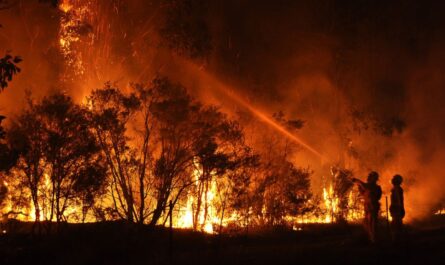Nassau, Bahamas – Hurricane Erin roared back to Category 4 strength overnight and began lashing the southeast Bahamas and the Turks and Caicos Islands early Monday, according to the National Hurricane Center (NHC). The powerful storm, the first hurricane of the 2025 Atlantic season, is expected to bring life-threatening surf, flooding rains, and dangerous rip currents across large portions of the Caribbean and U.S. East Coast this week.
Storm’s Location and Strength
As of the NHC’s 2 a.m. AST advisory, Erin was located 110 miles northeast of Grand Turk Island and about 935 miles south-southeast of Cape Hatteras, North Carolina. The hurricane is moving northwest at 12 mph, with maximum sustained winds of 130 mph.
Forecasters said Erin could strengthen further in the next 24 hours due to favorable atmospheric conditions. However, they cautioned that predicting intensity changes remains difficult.
Impact on the Caribbean
Erin has already skirted Puerto Rico and is now producing bands of heavy rainfall across the Virgin Islands and Puerto Rico, with totals ranging between 2 to 4 inches, and isolated amounts up to 8 inches. This raises the risk of flash floods, mudslides, and landslides, especially in mountainous areas.
Swells from Erin are expected to pound Puerto Rico, Hispaniola, and the Turks and Caicos Islands, creating hazardous seas and strong rip currents.
Forecast Path
The hurricane’s core is projected to pass east and northeast of the Turks and Caicos Islands and the southeastern Bahamas on Monday, then move between Bermuda and the U.S. East Coast by midweek.
According to AccuWeather meteorologists, North Carolina’s Outer Banks and coastal Virginia could see several feet of storm surge, leading to flooding and beach erosion. The storm may brush past Bermuda before turning north toward Canada.
By late Friday, Erin could be near southeastern Newfoundland, making it the closest potential landfall outside of the Caribbean.
Threats to the U.S. East Coast
The NHC has warned that Erin will generate life-threatening surf and rip currents along the Bahamas, much of the U.S. East Coast, Bermuda, and Atlantic Canada.
Read Also: Palm Beach Urges Preparedness as Tropical Storm Erin Strengthens
While the exact track remains uncertain, residents along the North Carolina and mid-Atlantic coasts have been urged to monitor the storm’s progress closely, with the possibility of strong winds and dangerous outer rainbands reaching land by midweek.
Hurricane Season Context
Accordimg to UPI, the 2025 Atlantic hurricane season, which began June 1, has already seen four named storms, though only Tropical Storm Chantal made U.S. landfall so far, causing severe flooding in North Carolina.
Erin is the strongest storm of the season to date, having briefly reached Category 5 intensity on Saturday morning before fluctuating in strength.
Meteorologists note that the peak of the season runs mid-August through mid-October, with 93% of U.S. hurricane landfalls historically occurring during this period, according to NOAA data.
Warnings in Effect
- Tropical storm warnings are currently active for the southeast Bahamas and Turks and Caicos Islands, located about 300 miles east of Miami.
- Forecasters expect heavy rainfall, coastal flooding, and dangerous surf across these islands through Tuesday.
Safety Reminder: Residents in the Bahamas, Bermuda, and along the U.S. East Coast should stay alert, prepare emergency kits, and follow local advisories as Hurricane Erin continues its path.
Are you in one of the areas under Erin’s watch? Share how you’re preparing in the comments on ibwhsmag.com.


 by
by 

